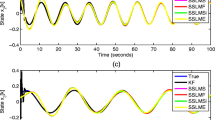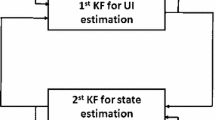Abstract
It is generally known that model-based estimation algorithms (such as Kalman filter and its family) perform better than the non-model-based algorithms [such as least mean square (LMS), recursive least squares] due to extra information available in terms of system dynamics (which can be used to provide state space model of the system). However, the computational complexity of the model based algorithms is very high. On the other hand, the convergence performance of model based least mean type algorithms [such as state space least mean (SSLM) algorithms] is slower and highly dependent on the step-size choice. Thus, the larger step size can provide faster convergence but gives poor steady-state excess mean square error (EMSE). To meet this conflicting demand, we propose to employ the q-calculus to minimize the generalized least mean cost function. The main advantage of using the q-calculus is that it can provide a nonlinear correction term in the adaptation of the state estimate vector. Consequently, this results in an intelligent adaptation by providing both faster convergence in the initial phase of adaptation and a lower steady-state EMSE in the final phase. The developed algorithms are termed as q-state space least mean (q-SSLM) algorithms. The performance of the proposed q-state space least mean square (q-SSLMS) algorithm is also investigated both in terms of convergence in the mean and the mean square sense. The supremacy of the proposed algorithm is validated by performing several simulations and it is also contrasted with the performance of the well-known Kalman filter. Finally, the theoretical convergence analysis is also validated via simulations.







Similar content being viewed by others
Notes
Accuracy of the algorithm depends mainly on the dynamics of the problem.
The SSLM algorithm is contrasted with the KF in terms of optimality and computational complexity in the Remarks presented at the end of this section.
The choice of matrix \(\mathbf{G}\) is discussed in the Remarks.
The analysis for higher values of L is quite involved which can be a future arena to explore.
For higher noise variance, the system simulation time resolution had to be increased for stable simulation of the system.
Similar to example 1, for higher noise variance the system simulation time resolution had to be increased for stable simulation of the system.
References
A. Ahmed, M. Moinuddin, U.M. Al-Saggaf, State space least mean fourth algorithm for dynamic state estimation in power systems. Arab. J. Sci. Eng
A. Ahmed, M. Moinuddin, U.M. Al-Saggaf, State space least mean fourth algorithm, in International Conference on Electrical and Computer Engineering
A. Ahmed, M. Moinuddin, U.M. Al-Saggaf, State space least mean square for state estimation of synchronous motor, in International Conference on Electrical and Computer Engineering
A. Ahmed, U.M. Al-Saggaf, M. Moinuddin, State space least mean fourth algorithm for state estimation of synchronous motor. Asian J. Eng. Sci. Technol. 4, 9–12 (2014)
U.M. Al-Saggaf, M. Moinuddin, M. Arif, A. Zerguine, The q-least mean squares algorithm. Sig. Process. 111, 50–60 (2014)
I. Arasaratnam, S. Haykin, R.J. Elliott, Discrete-time nonlinear filtering algorithms using Gauss–Hermite quadrature. IEEE Trans. Electromagn. Compat. 95, 953–977 (2007)
C.K. Chui, G. Chen, Kalman Filtering with Real-Time Applications, 4th edn. (Springer, Berlin, 2009)
P. Diniz, Adaptive Filtering: Algorithms and Practical Implementation, (Springer, Berlin, 2010). https://books.google.co.nz/books?id=DYancQAACAAJ
T. Ernst, The history of q-calculus and a new method. U.U.D.M. Report 2000:16. Department of Mathematics, Uppsala University, Sweden (2000)
G. Evensen, The ensemble Kalman filter: theoretical formulation and practical implementation. Ocean Dyn. 53(4), 343–367 (2003). doi:10.1007/s10236-003-0036-9
B. Farhang-Boroujeny, Adaptive Filters: Theory and Applications (Wiley, London, 1999). https://books.google.co.nz/books?id=jxd-QgAACAAJ
S. Haykin, Adaptive Filter Theory, 3rd edn. (Prentice Hall, Prentice, 1996)
S. Haykin, B. Widrow, Least-Mean-Square Adaptive Filters, Adaptive and Cognitive Dynamic Systems: Signal Processing, Learning, Communications and Control (Wiley, London, 2003). https://books.google.co.nz/books?id=U8X3mJtawUkC
F.H. Jackson, On q-functions and a certain difference operator. Trans. R. Soc. Edinb. 46, 253–281 (1908)
T. Kailath, Linear Systems, Information and System Sciences Series (Prentice-Hall, Prentice, 1980). https://books.google.co.nz/books?id=ggYqAQAAMAAJ
H.K. Khalil, Nonlinear Systems, 3rd edn. (Prentice Hall, Prentice, 2001)
J. Koekoev, A note on the \(q\)-derivative operator. J. Math. Anal. Appl. 176, 627–634 (1993)
B. Lathi, Linear Systems and Signals, Oxford Series in Electrical and Computer Engineering (Oxford University Press, Oxford, 2005). https://books.google.co.nz/books?id=7resQgAACAAJ
M.B. Malik, M. Salman, State-space least mean square. Digit. Signal Proc. 18, 334–345 (2008)
R.J. Meinhold, N.D. Singpurwalla, Understanding the Kalman filter. Am. Stat. 37(2), 123–127 (1983)
M. Moinuddin, U.M. Al-Saggaf, A. Ahmed, Family of state space least mean power of two-based algorithms. EURASIP J. Adv. Signal Process. (2015). doi:10.1186/s13634-015-0219-9
R. Olfati-Saber, Distributed Kalman filter with embedded consensus filters, in Proceedings of the 44th IEEE Conference on Decision and Control, 2005, pp. 8179–8184
A.H. Sayed, Fundamentals of Adaptive Filtering (Wiley, London, 2003)
D. Sierociuk, P. Ziubinski, Fractional order estimation schemes for fractional and integer order systems with constant and variable fractional order colored noise. Circuits Syst. Signal Process. 33(12), 3861–3882 (2014). doi:10.1007/s00034-014-9835-0
D. Sierociuk, M. Macias, W. Malesza, G. Sarwas, Dual estimation of fractional variable order based on the unscented fractional order Kalman filter for direct and networked measurements. Circuits Syst. Signal Process. 35(6), 2055–2082 (2016). doi:10.1007/s00034-016-0255-1
A.C. Soterroni, R.L. Galski, F.M. Ramos, The \(q\)-gradient method for global optimization. arXiv: 1209.20484v2 [Math.OC]
E.A. Wan, R.V.D. Merwe, The unscented Kalman filter for nonlinear estimation, in Adaptive Systems for Signal Processing, Communications, and Control Symposium, 2000, pp. 153–158
Acknowledgements
The authors acknowledge the support provided by King Abdulaziz University and the Centre of Excellence in Intelligent Engineering Systems to carry out this work.
Author information
Authors and Affiliations
Corresponding author
Rights and permissions
About this article
Cite this article
Ahmed, A., Moinuddin, M. & Al-Saggaf, U.M. q-State Space Least Mean Family of Algorithms. Circuits Syst Signal Process 37, 729–751 (2018). https://doi.org/10.1007/s00034-017-0569-7
Received:
Revised:
Accepted:
Published:
Issue Date:
DOI: https://doi.org/10.1007/s00034-017-0569-7




